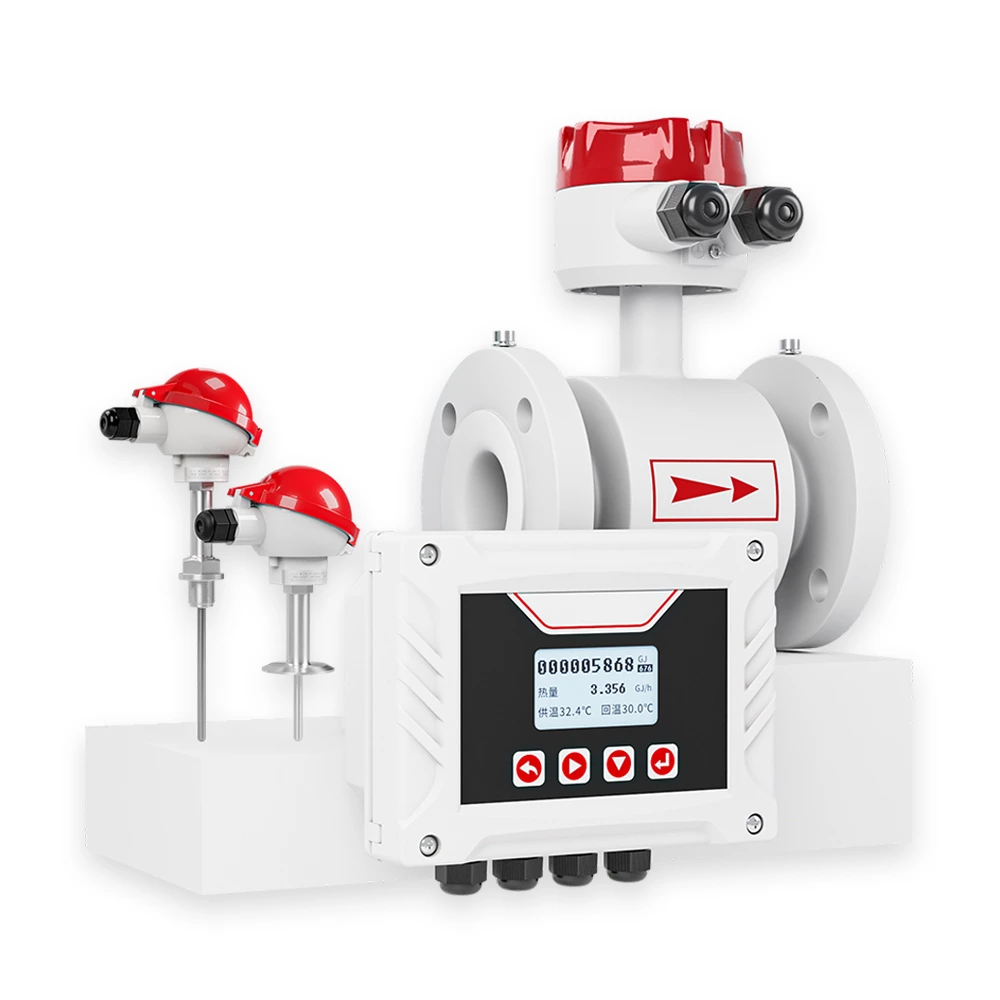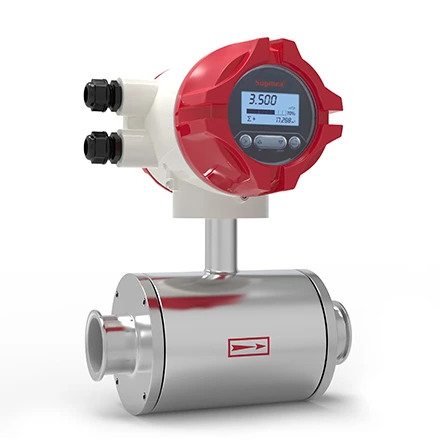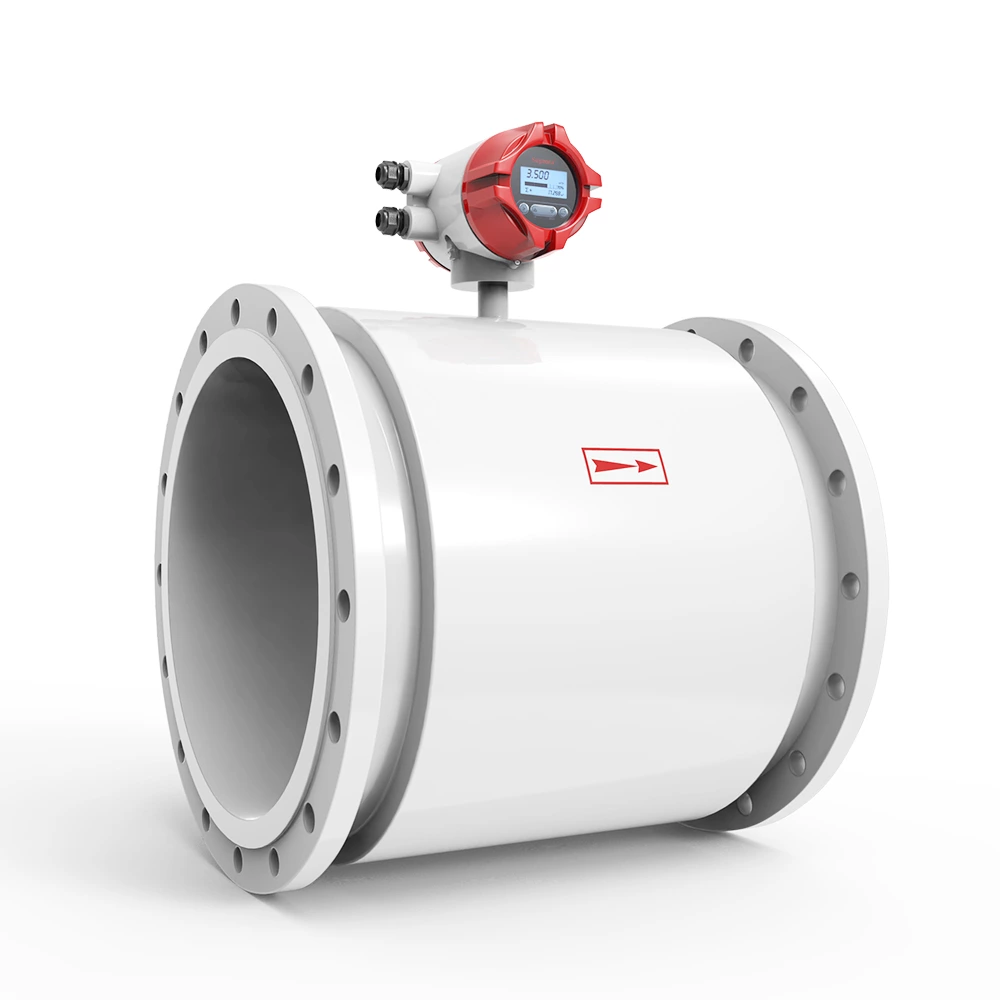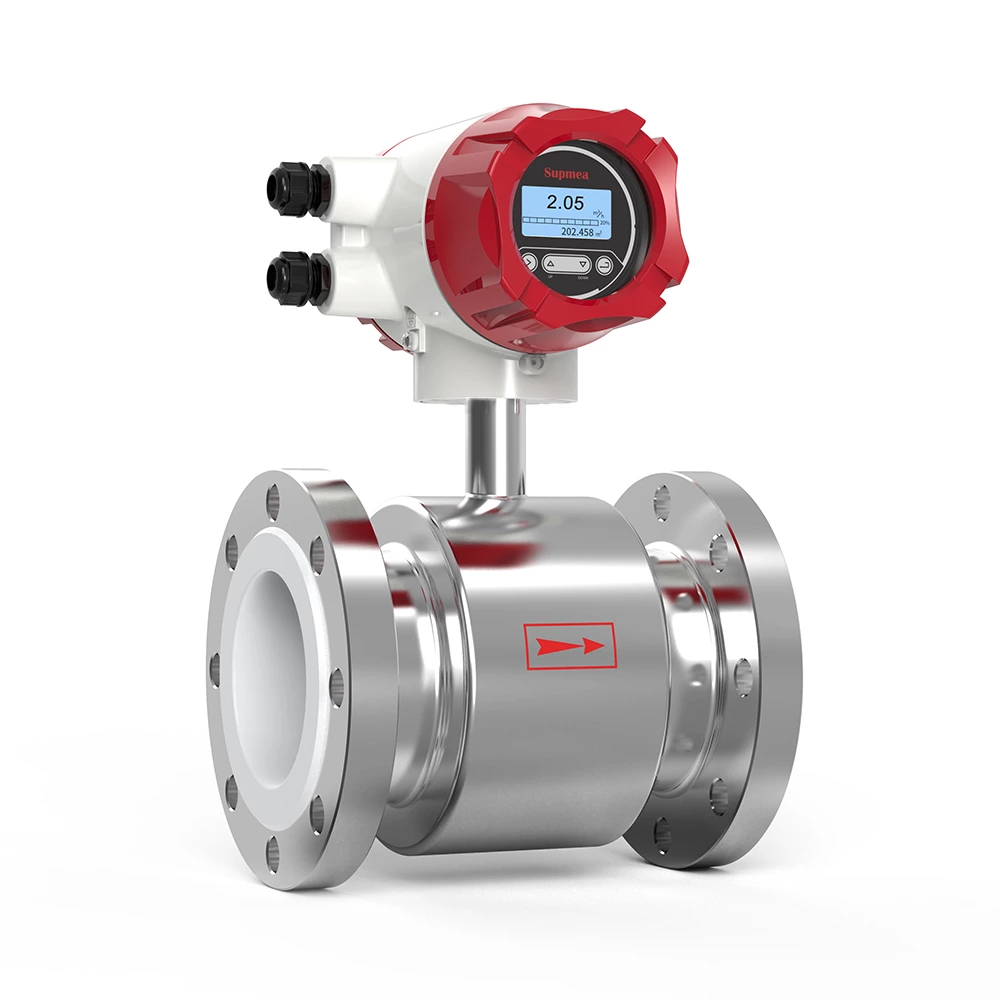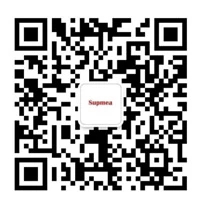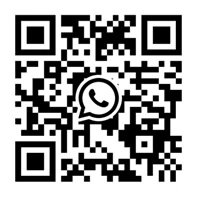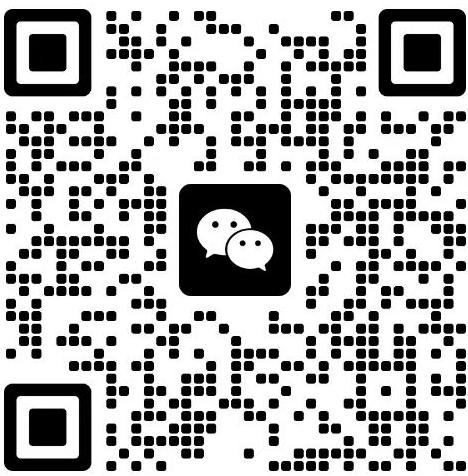What is A BTU Meter And How Does It Work?
What Is BTU?
BTU, full form British Thermal Unit, is the thermal energy measurement unit for calculating the amount of heat needed to raise the temperature of one pound of water by one degree Fahrenheit. In the heating and cooling systems, this parameter is the key point to determine how much heat an AC or heater can produce or withdraw from a room or space, which matters especially when selecting an appropriate HVAC device for heating or cooling purposes in a given area.
Additionally, this measuring unit is widely seen in the fuel energy measurement scenes like natural gas, propane, and heating oil etc. It helps evaluate how efficiently these fuels can transfer heat and what they'll cost to use for heating.

What Is a BTU Meter?
A BTU meter, also known as an energy meter, is an electronic instrument designed for measuring the heat energy generated or consumed in a heating or cooling system. It functions by measuring the flow rate and temperature difference of liquids flowing through the heat exchanger, then calculating and integrating all data to provide you with accurate readings. This thermal meter leaves an extremely impressive performance in optimizing efficiency, spotting leaks and errors, and reducing energy waste in HVAC systems.
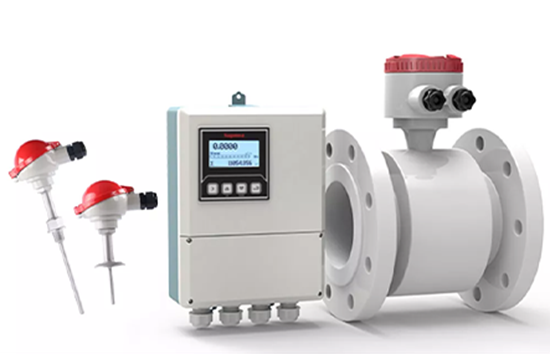
What does a BTU meter consist of?
To know a BTU utility from a full-scale, it's essential to know its components first of all. This precise meter consists of two temperature sensors located in the inlet and outlet of the heat exchanger for measuring the temperature difference, one flow sensor soldered for testing the flow rate, and one calculator positioned stationarily for calculating the amount of heat energy transferred through the heat exchanger based on the data given by the two components above.
What incredible components and seamless processes give BTU analyzers such high praise across commercial, industrial, and residential applications!
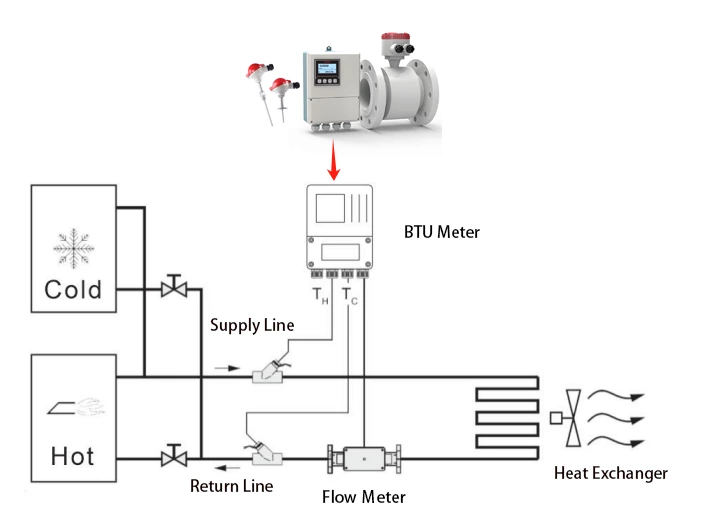
BTU Meter Working Principle
Since we have explored the inner structure of the BTU analytic equipment, now let’s explore how this thermal meter measures the heat created or needed in an Air Handling Unit or an HVAC system.
The BTU meter formula goes like this:
Load = (Flow Rate x ΔT)/24
Where:
- Flow Rate refers to how much water goes through the pipeline in one minute, which always shows up in Gallons Per Minute. The flow sensor installed in the BTU energy measurement is designed for doing this.
- ΔT is the parameter indicating the temperature difference of the water in the return line and supply line of the AHU or HVAC system with a unit of ℉. In short, ΔT = Return Line temperature - Supply Line temperature. It is measured by the temperature sensors built into the BTU management device.
Let’s take an example:
When the chilled water enters the Supply line at 5°C(41 Fahrenheit) and exits from the Return line with 7 °C(44.6 Fahrenheit), then the Temperature Difference (ΔT) equals 7 °C(44.6 Fahrenheit) minus 5°C(41 Fahrenheit) =3.6℉.
Let's set the flow rate as 300GPM (you can measure the real flow rate of the moving liquids with the flow sensor), then:
Load = (Flow Rate x ΔT)/24 =(300GPM x 3.6 ℉)/24=45 TONS
TONS means a Ton-hour of refrigeration, then let's convert the TONS value to kWh value, that is 45 TONS x 3.53 = 157.95Kwh.
Additionally, you can even determine the specification of an AHU, HVAC device, or the heat and cooling system with this table directly, based on the room square footage:
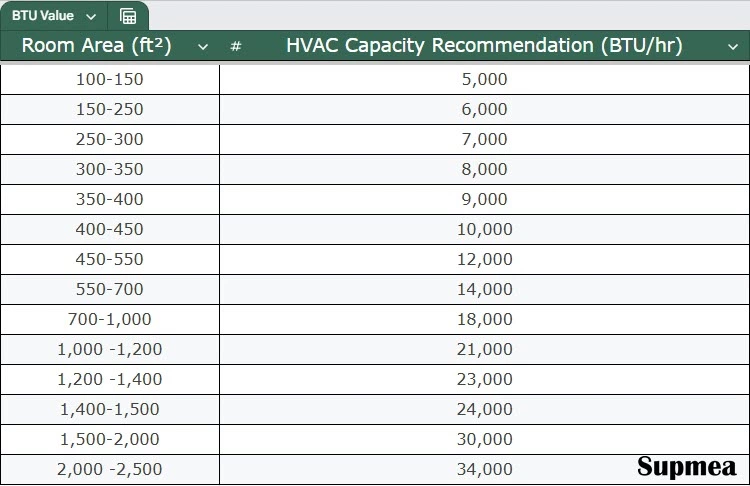
See? It's quite simple to calculate the BTU load value. Yet if you prefer a simpler calculation method, click here to input the data measured by the BTU facility and get the BTU load statistics straightforwardly.
Additionally,
What can the BTU load data be used for?
Once you get the values by measuring the flow rate and temperature difference in systems like HVAC, air handling units, furnaces, heat pumps, and industrial processing, you can make full use of them in the following aspects:
Precise billing and budget allocation
A BTU load data conveys the exact amount of energy needed for heating or cooling, helps decide the final energy cost in sorts of projects like district heating, residential tenant buildings, condominium heating systems, commercial architecture heat and cooling suppliers, household heating devices, and even greenhouse temperature adjustments.
Equipment size selection
When we have the BTU load results used to raise or reduce the temperature by one degree in a given area, we can select an appropriate heater or cooler machine in various lineups with specific parameters. In such a case, the chosen product matches your industrial or home demands perfectly with no insufficient function or over-sufficient energy usage.
Performance monitoring and maintenance
An excessively explosive or too slumping BTU load number indicates there is something wrong with the BTU meter inside, which can be the energy leaks, pump failures, fouling culprits in the pipe, the malfunction of the flow sensor, temperature sensor, or calculator. No matter what the final culprit is, when the BTU load gets abnormal, you’d better check the BTU measuring device ASAP to nip any growing loss in the bud before it worsens.
The moment that you uncover the primary issue, then maintenance to fix the troubleshoot it is a must for the BTU meter’s durability and further performance.
BTU Meter Calculation
Or, you can complete the BTU meter calculation in this way. BTU meter calculations are based on the measurement of flow rate and temperature difference in a heat transfer system. The following are the steps involved in BTU meter calculations:
- Determine the flow rate: The flow rate of the heat transfer fluid is measured using a flow meter or a differential pressure sensor. The flow rate is typically measured in gallons per minute (GPM) or liters per minute (LPM).
- Measure temperature difference: Two temperature sensors are used to measure the temperature difference between the inlet and outlet of the heat transfer system. The temperature sensors are typically mounted on the pipe, and they measure the temperature in degrees Celsius or Fahrenheit.
- Calculate heat transfer: The heat transfer rate can be calculated using the following formula:
Q = m * c * delta T
- Where Q is the heat transfer rate (in BTU/hr or kW), m is the mass flow rate (in lb/hr or kg/hr), c is the specific heat of the fluid (in BTU/lb°F or kJ/kg°C), and delta T is the temperature difference (in °F or °C).
- Calculate total heat transfer: The total heat transfer can be calculated by integrating the heat transfer rate over a period of time. This is typically done using a data logger or a building automation system that records the flow rate and temperature difference over time.
- Convert to BTUs: The total heat transfer is typically expressed in BTUs or kilowatt-hours (kWh). One BTU is equivalent to the amount of energy required to raise the temperature of one pound of water by one degree Fahrenheit.
- Analyze data: The BTU meter data can be used to identify energy-saving opportunities and optimize the performance of the heat transfer system. This can be done by comparing the data to historical trends or benchmarking against similar systems.
BTU meter calculations are essential for monitoring energy usage and identifying opportunities to improve efficiency in heat transfer systems. By accurately measuring and analyzing energy consumption, building owners and facility managers can make informed decisions about system design, operation, and maintenance.

How Many BTU Meter Types?
Different BTU meters are configured with different parameters for a wide range of applications. Here, let’s review some common types of BTU thermal meters:
In-line BTU meters
These meters are installed directly in the pipeline to measure the flow rate and temperature difference of the flowing fluids. With two temperature sensors and a flow meter being integrated in a separate unit, the inline BTU meters are typically used in closed-loop HVAC systems and available in various sizes to accommodate different pipe diameters.

Clamp-on BTU meters
Also known as strap-on BTU meters, the clamp-on BTU analyzers are attached to the outside of the pipe. It adopts ultrasonic sensors to measure the flow rate and temperature difference of the target fluid passing through the pipe. The strap-on BTU meters are commonly used in applications where it is difficult or impractical to install an in-line meter, such as retrofitting existing HVAC systems.
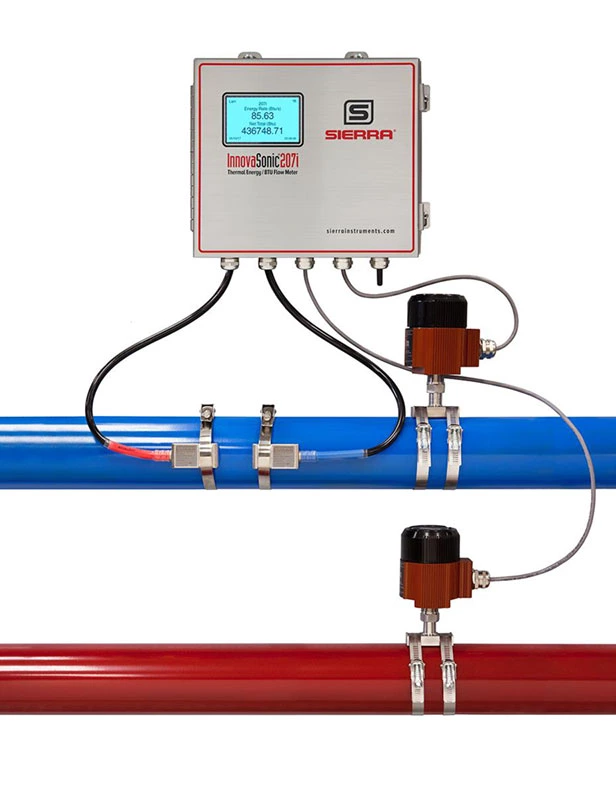
Portable BTU meters
These meters are designed for temporary installations, which are typically used for commissioning, testing, or troubleshooting HVAC systems. With a compact and portable design, they can be easily moved from one place to another to verify the accuracy of in-line or clamp-on meters.

Thermal dispersion BTU meters
Thermal dispersion BTU meter, also known as thermal mass flow meter or immersible mass flow meter, measures flow moving through the closed conduits based on the thermal dispersion principle, which calculates the flow rates and energy transmitted by detecting the temperature differences. This meter is usually seen in loads of scenes like fluids, chemicals, pharmaceuticals, food processing, and environmental monitoring industries.
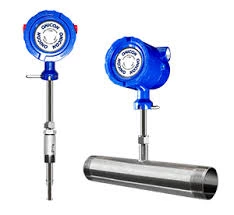
Vortex shedding BTU meters
A vortex shedding BTU meter is exactly one type of volumetric flow meter operating on the principle of vortex shedding. It makes use of a natural effect that happens when a liquid flows over a bluff item; the swirling vortices are created behind it. These vortices form in a repeating pattern; meanwhile, the frequency at which they're generated is directly related to how fast the liquid is flowing.
No moving parts inside the flow stream makes the vortex shedding BTU meters remarkable in sorts of BTU tools. With stainless steel, brass, or even plastic design, you can discover it's busy in dealing with the high-consumable or high-maintenance scenes.
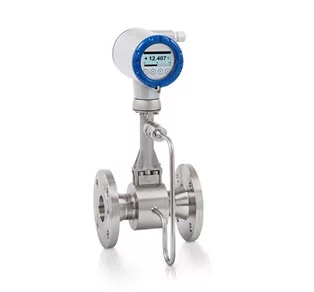
Electromagnetic BTU meters
An Electromagnetic BTU meter, also called magmeter, works on the principle of electromagnetic induction to measure the thermal energy consumed by chilled water. It is a basic indicator for measuring thermal energy in commercial and residential buildings. This type of magmeters are usually used in commercial and industrial as well as office buildings for chilled water systems, HVAC, heating systems, etc.
Supmea electromagnetic BTU meter, with superb flow accumulation feature, can measure the instantaneous flow of conductive liquid or liquid-solid two-phase fluid. It works in this pattern: the hot water (cold water) supplied by the heat source flows into the heat converter system at a higher (lower) temperature, then it flows out at a lower (higher) temperature.
During this process, heat is released or absorbed through a heat exchanger. When the water flows through the heat exchange system, according to the flow rate given by the flow sensor and the temperature difference given by the paired temperature sensors, as well as the elapsed time of the water flow, the calculator calculates and displays the heat released or absorbed by the system.
If you wonder more detailed info about this incomparable BTU meter, please visit:
We list almost all kinds of BTU meters on the market here. Configured with different designs and parameters, each meter has its advantages and limitations. For the BTU meter selection, you ought to consider factors thoroughly, like specific application, working principle, operating conditions, and installation requirements etc. Once you select the optimum toolset, accurate measurement of heat energy transferred can be achieved.
BTU Meter for Chilled Water
A BTU meter for chilled water is a type of flow meter used to measure the amount of heat energy transferred in chilled water systems. It is typically used in HVAC applications, such as cooling towers, air handling units, and chiller plants.
The BTU meter for chilled water works by measuring the flow rate and temperature difference of the chilled water passing through the meter. The meter consists of two temperature sensors, a flow sensor, and a calculator. One temperature sensor is placed at the inlet and the other at the outlet of the heat exchanger. The flow sensor measures the rate of flow of the chilled water passing through the meter.
The temperature difference between the inlet and outlet of the chilled water system is measured by the two temperature sensors. The flow rate of the chilled water is measured by the flow sensor. The calculator then uses this data to calculate the amount of heat energy that has been transferred through the system.
One advantage of using a BTU meter for chilled water is that it enables accurate measurement of the energy consumption of cooling systems, allowing for better control and optimization of energy usage. This can result in significant cost savings and improved efficiency of HVAC systems. Additionally, BTU meters for chilled water are non-invasive and do not require cutting into pipes or shutting down the system for installation, reducing downtime and maintenance costs.
Another advantage is that BTU meters for chilled water can be easily integrated into building automation systems, allowing for remote monitoring and control of energy consumption. This can help building owners and facility managers to better manage their energy usage, reduce waste, and meet sustainability goals.
BTU meters for chilled water provide a valuable tool for accurately measuring and monitoring the energy consumption of HVAC systems, enabling better control and optimization of energy usage, and reducing costs and environmental impact.

BTU Meter Installation
The installation of a BTU meter involves several steps to ensure accurate and reliable measurement of heat energy transfer. Here are some of the key aspects to consider when installing a BTU meter:
- Meter location: The meter should be located in a section of the pipeline where the flow is fully developed and there is a consistent flow profile. This can be achieved by ensuring that there are no bends or obstructions upstream of the meter, and that the meter is installed at least 10 pipe diameters downstream of any elbows, valves, or other flow disturbances.
- Meter orientation: BTU meters should be installed in the correct orientation, with the flow arrow pointing in the direction of flow. The meter should also be installed vertically, with the sensors in a horizontal position.
- Sensor placement: The temperature sensors should be placed in the correct location to ensure accurate measurement of the temperature difference. In an in-line meter, the sensors should be placed at the inlet and outlet of the heat exchanger, while in a clamp-on meter, the sensors should be placed on opposite sides of the pipe, with the flow path between them.
- Calibration: The BTU meter should be calibrated prior to installation to ensure accurate measurement of heat energy transfer. This involves setting the meter's flow and temperature parameters to match the specific system requirements and verifying the accuracy of the measurement.
- Electrical connections: The meter should be wired correctly, with the appropriate connections made to the temperature and flow sensors, and to the building automation or control system.
- Commissioning: Once the meter is installed and calibrated, it should be commissioned to ensure that it is functioning correctly and providing accurate measurement of heat energy transfer. This involves running the system and verifying that the meter readings match the expected values, and making any necessary adjustments to the meter or system settings.
In short, the installation of a BTU meter requires careful attention to detail and proper planning to ensure accurate and reliable measurement of heat energy transfer. By following the manufacturer's installation instructions and best practices, the meter can be installed correctly and provide valuable data for optimizing energy usage and reducing costs.
BTU Meter VS. Energy Meter
If you want to know what's different between a BTU meter and an energy meter, you've come to the right article. BTU meters and energy meters are both used to measure energy usage, but they differ in the way they measure and report energy consumption. Here are the key differences between the two:
- Measurement principle: A BTU meter measures the thermal energy transferred in a heat transfer system, while an energy meter measures the electrical energy consumed by an electrical system.
- Units of measurement: A BTU meter measures energy in British Thermal Units (BTUs), while an energy meter measures energy in kilowatt-hours (kWh).
- Accuracy: BTU meters are generally more accurate than energy meters for measuring thermal energy transfer. This is because BTU meters can take into account factors such as temperature difference, specific heat capacity, and flow rate of the heat transfer fluid.
- Application: BTU meters are typically used in buildings and facilities that use hot or chilled water for heating, ventilation, and air conditioning (HVAC) systems. Energy meters are used for monitoring and measuring electricity consumption in commercial and residential buildings.
- Cost: The cost of BTU meters and energy meters can vary depending on the level of accuracy, features, and installation requirements. BTU meters are generally more expensive than energy meters due to their more complex measurement technology.
Overall, both BTU meters and energy meters play an important role in measuring and monitoring energy consumption. They provide valuable data that can be used to identify energy-saving opportunities and optimize the performance of building systems. The choice of which meter to use will depend on the specific application and energy usage requirements of the building or facility.

